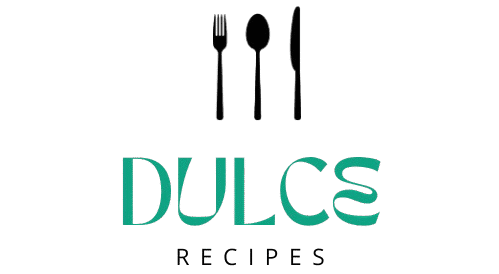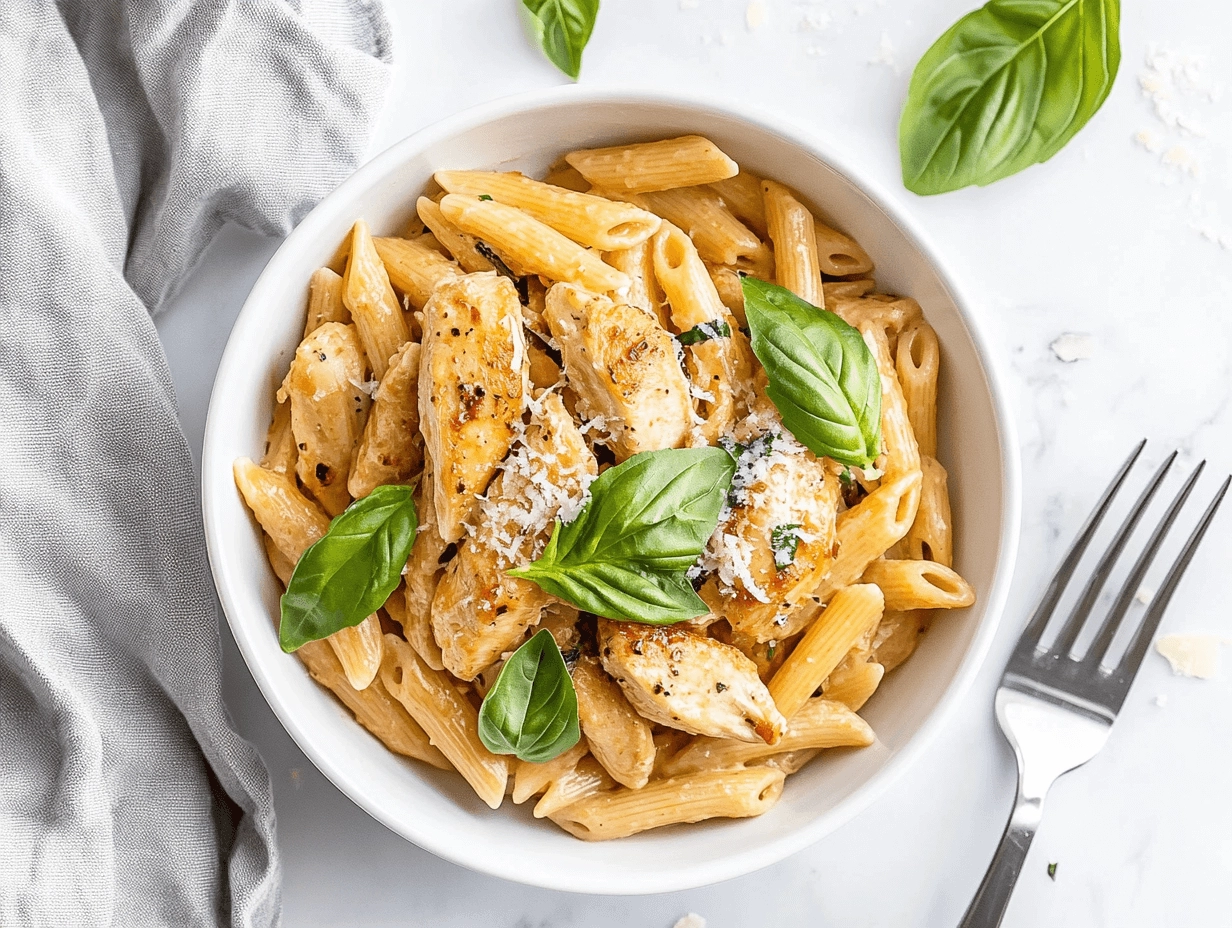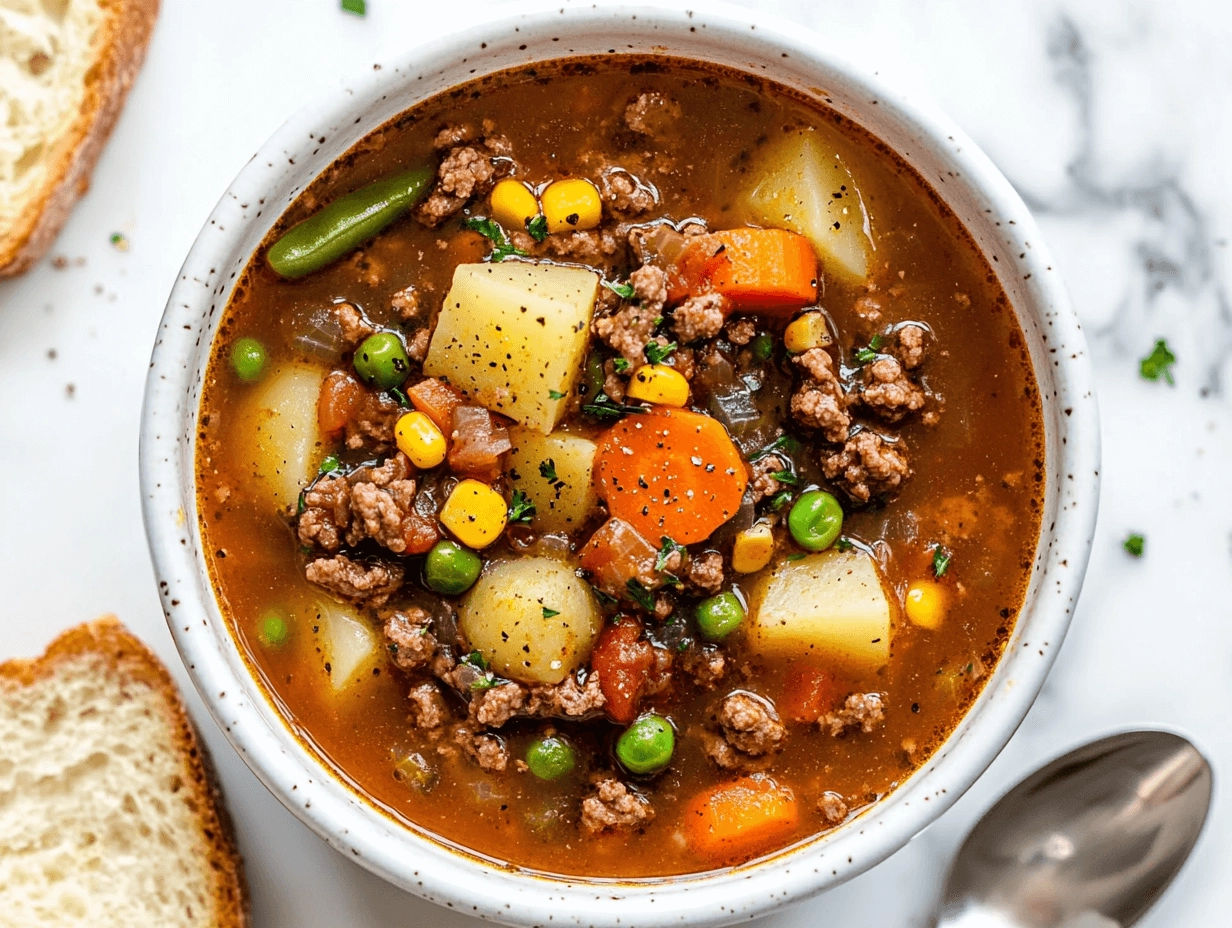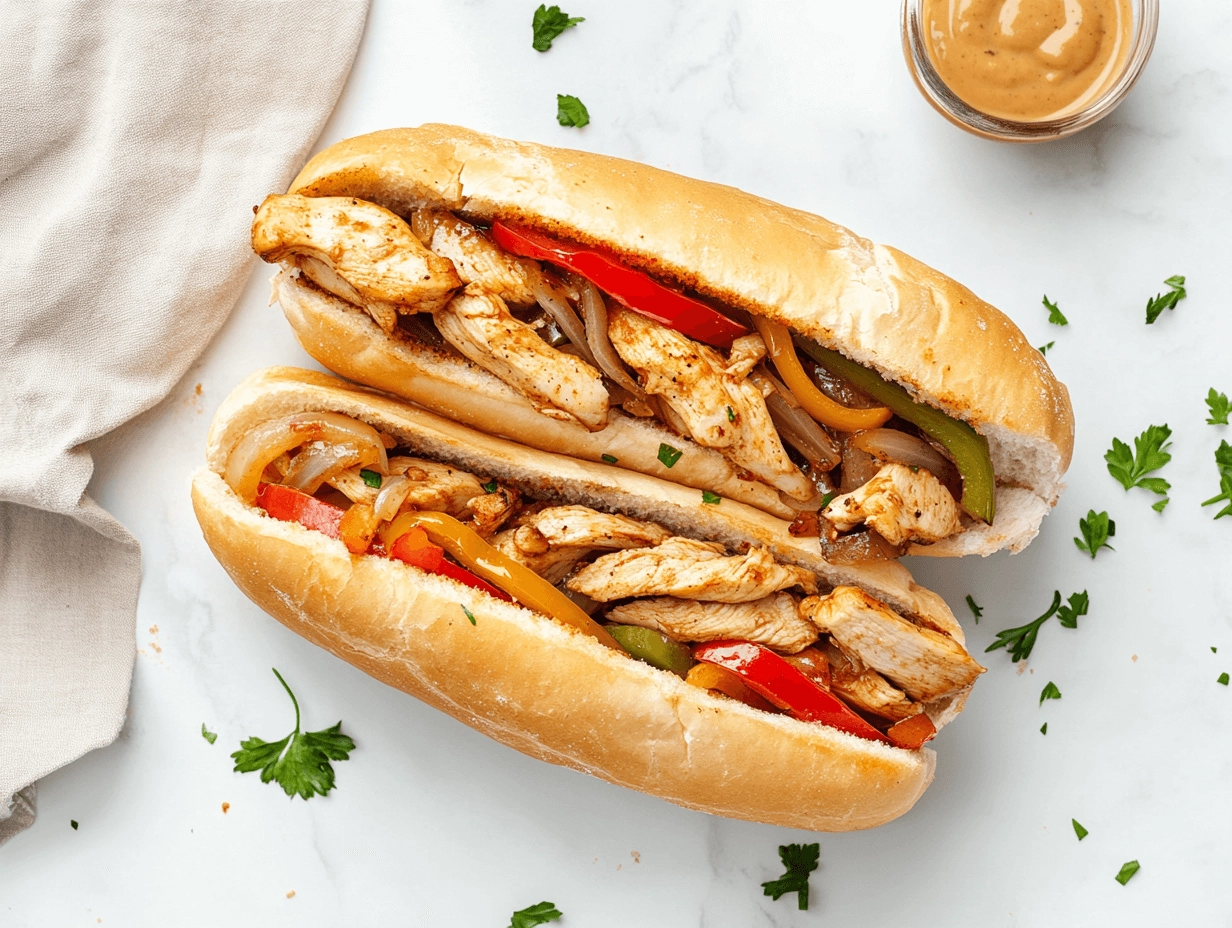Ever found yourself staring into the fridge, wanting something tasty but easy? Asian rice bowls might be just what you need. They’re not just meals; they’re a blank canvas for creativity. They’re also a quick fix for busy nights and a way to dive into Asian cuisine without needing to be a pro in the kitchen.
Rice dishes have gone from ordinary to extraordinary, opening up a world of possibilities. Whether you’re cooking at home or exploring new recipes, these rice bowls are a mix of health, taste, and ease. Imagine making a meal as good as a restaurant’s in just 30 minutes, with protein, colorful veggies, and tasty sauces.
These bowls can be made with brown rice or even cauliflower rice, fitting your diet needs. You can choose from chicken to tofu, making sure there’s something for everyone in this exciting rice dish world.
Table of Contents
Discover more delicious recipes and ideas by visiting our homepage!
Understanding the Art of Asian Rice Bowls
Asian rice bowls are a big part of many cultures. They have been around for centuries. Making these dishes is more than just cooking; it’s a journey into rich flavors and traditions.
Origins and Cultural Significance
The world of Asian rice bowls is rich and varied. Each culture has its own special rice bowl dish:
- Donburi in Japan: A classic rice bowl with various toppings
- Bibimbap in Korea: A colorful mixed rice dish
- Thunder tea rice in Hakka cuisine: A nutritious historical dish
What makes a rice bowl Asian? Each place has its own twist, using local ingredients and cooking ways. In Japan, for example, rice bowls are very personal, with each family member having their own bowl.
Basic Components of Traditional Rice Bowls
Traditional Asian rice bowls have a few key parts:
- A base of perfectly cooked rice
- Protein (fish, meat, or tofu)
- Fresh vegetables
- Flavorful sauce or seasoning
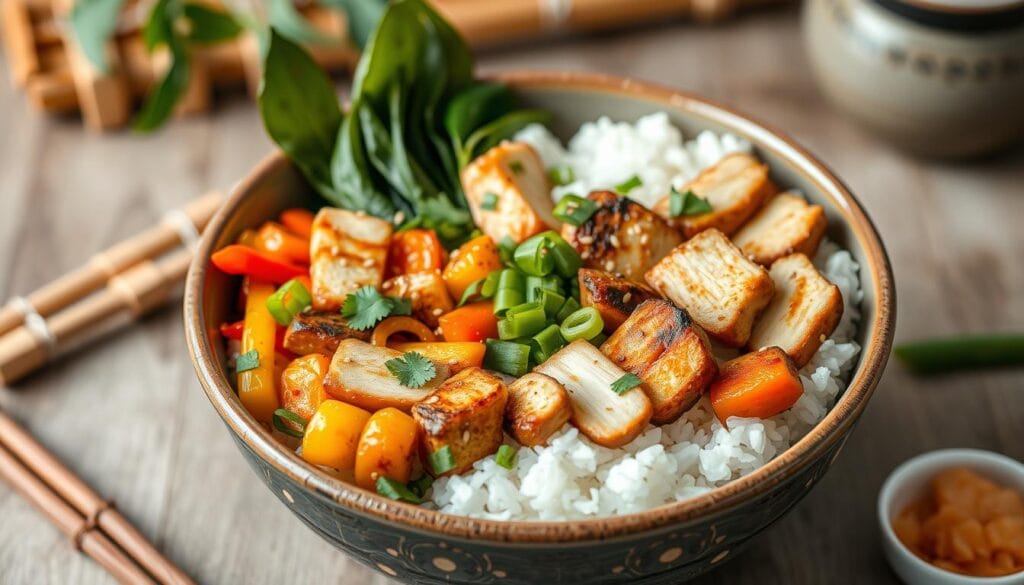
Essential Cooking Techniques
Learning to make Asian rice bowls takes skill. You need to steam rice right, stir-fry veggies fast, and get the flavors just right. Each rice bowl style has its own special way of cooking.
By learning these techniques, you can make authentic and tasty Asian rice bowls. They will show you the true spirit of traditional cooking.
Essential Ingredients for Perfect Rice Bowls
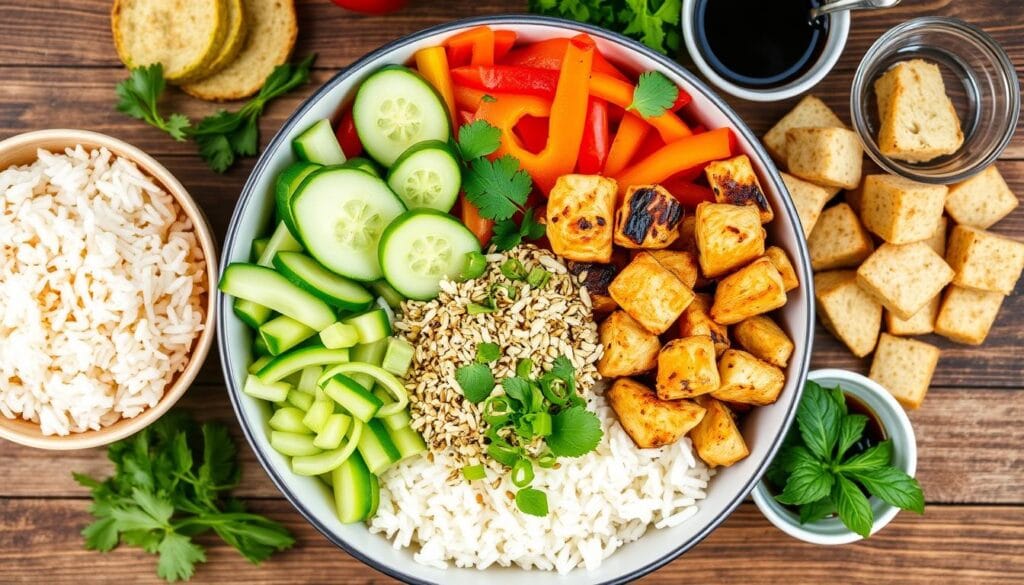
Making tasty rice bowls begins with knowing the basics. These dishes mix flavors and are both healthy and filling. The key is to pick top-notch ingredients that go well together.
Looking into what’s in a rice bowl, you’ll see a few main parts:
- Rice Base: Pick from over 40,000 rice types, like jasmine, basmati, or brown rice
- Protein Sources: You can choose from:
- Grilled chicken
- Seared beef
- Tofu
- Salmon
- Shrimp
- Fresh Vegetables: Add color and health with fresh veggies like:
- Broccoli
- Bell peppers
- Snap peas
- Carrots
- Edamame
Sauces are key to making a rice bowl taste amazing. Asian sauces like teriyaki, soy sauce, sriracha, and sesame oil add flavor. They also make your dish richer.
By mixing these key ingredients well, you can make rice bowls as good as those in restaurants. Make sure to balance the flavors, textures, and health for a great meal.
The Foundation: Choosing and Cooking the Right Rice
Starting with the right rice is key to making tasty rice dishes and grain bowls. The type of rice you pick can turn a simple meal into a memorable one.
Types of Rice for Asian Bowls
Each rice variety adds its own special touch to your bowls. Here are some popular ones:
- Jasmine Rice: Fragrant and soft, perfect for many Asian dishes
- Short-Grain Rice: Sticky, great for sushi-style bowls
- Basmati Rice: Light and fluffy, suits Indian-inspired bowls well
- Brown Rice: Rich in nutrients, with a nutty taste
Perfect Rice Cooking Methods
| Cooking Method | Pros | Cooking Time |
|---|---|---|
| Stovetop | Traditional, precise control | 20-25 minutes |
| Rice Cooker | Hands-off, consistent results | 30-40 minutes |
| Instant Pot | Quick, multiple function | 10-15 minutes |
Storage and Reheating Tips
Day-old rice is the best for dishes! Keep cooked rice in airtight containers in the fridge. When reheating, add a bit of water to keep it moist.
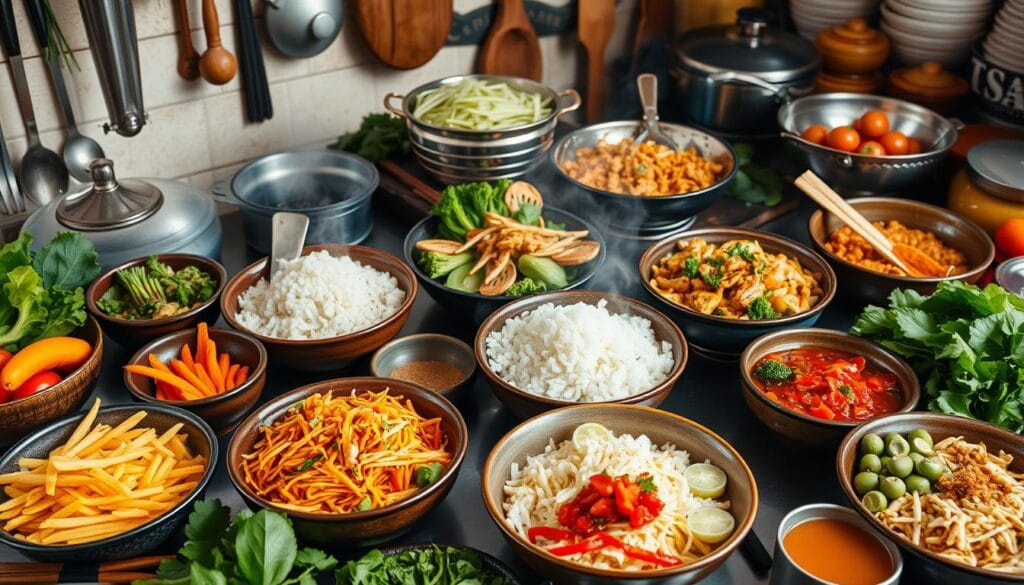
Mastering these rice techniques will take your grain bowls to the next level. They’ll become true culinary delights.
Mastering the Asian Rice Bowl Sauce

Making the perfect sauce is key to taking your Asian rice bowl to the next level. Asian flavors need balanced and complex sauces. These sauces add depth and excitement to every bite.
Knowing the basics of sauce making is important. The best Asian sauces mix:
- Sweet elements (honey, sugar)
- Salty components (soy sauce, fish sauce)
- Acidic touches (rice vinegar, lime juice)
- Umami boosters (miso, garlic)
Let’s dive into a classic teriyaki sauce recipe. It’s packed with authentic Asian flavors:
| Ingredient | Quantity |
|---|---|
| Soy Sauce | 1/2 cup |
| Mirin | 1/4 cup |
| Honey | 2 tablespoons |
| Minced Garlic | 2 cloves |
| Grated Ginger | 1 teaspoon |
Here are some tips for making the best sauce:
- Whisk ingredients until fully combined
- Simmer for 5-7 minutes to develop rich flavors
- Adjust sweetness or saltiness to taste
- Store in refrigerator for up to one week
If you’re short on time, store-bought sauces can be a good choice. Choose brands with natural ingredients and few preservatives for real Asian flavors.
Spicy Salmon Brown Rice Bowl Recipe
Looking for a tasty and healthy lunch? This spicy salmon brown rice bowl is perfect. It’s full of protein and exciting flavors, turning a simple meal into a fun adventure.
Essential Ingredients
- 1.5 lbs center-cut salmon filet
- 4 cups steamed brown rice
- 1/4 cup soy sauce
- 2 tablespoons honey
- 1 tablespoon sriracha
- 2 grated garlic cloves
- 2 teaspoons ginger paste
Preparation Technique
- Marinate salmon in soy sauce mixture for 20-30 minutes
- Preheat oven to 400°F
- Bake salmon for 8-10 minutes
- Prepare spicy mayo by mixing mayonnaise and sriracha
- Assemble rice bowl with salmon, vegetables, and sauce
Customization Options
Your rice bowl is super flexible. Try using tofu or chicken instead of salmon. You can also swap brown rice for cauliflower rice. Adjust the spice to your liking. Add avocado, edamame, or cucumber for extra nutrition and crunch.
| Nutritional Value | Per Serving |
|---|---|
| Calories | 634 kcal |
| Protein | 45g |
| Carbohydrates | 65g |
| Fat | 21g |
This lunch is a great mix of taste and nutrition. It’s perfect for busy people and those who care about their health.
Vegan Asian Rice Bowl with Crispy Tofu
Take your veggie bowl to the next level with this vegan Asian rice bowl. It’s a buddha bowl that’s both nutritious and flavorful. This recipe turns simple ingredients into a dish that’s truly special.
To make crispy tofu, you need to press the tofu first. Press it for 30 minutes to get rid of extra liquid. This makes the tofu crispy on the outside and soft on the inside. Then, coat it with 1 tablespoon of cornstarch for that golden crunch.
Here’s what you’ll need for your Vegan Asian Rice Bowl:
- 1 block (14 oz) extra firm tofu
- 1 cup jasmine rice
- 2 cups mixed vegetables
- ¼ cup low sodium soy sauce
- 1 tablespoon chili paste
- 1 teaspoon minced garlic
There are a few ways to cook the tofu. You can air fry it at 370°F for 15 minutes, tossing it every 5 minutes. Or, bake it at 400°F for 20-25 minutes. The goal is to get it crispy and golden brown, adding texture to your dish.
Nutrition Highlights:
| Nutrient | Amount |
|---|---|
| Calories | 416 kcal |
| Protein | 19g |
| Carbohydrates | 62g |
| Fat | 10g |
Pro tip: Prepare your ingredients ahead of time to make this veggie bowl quick and easy. Add protein-rich toppings like edamame or green peas for extra nutrition. Try different vegetables and sauces to keep your buddha bowls fresh and exciting!
Build Your Own Asian Rice Bowl Guide
Making the perfect asian rice bowl is a fun journey. It lets you play with flavors, textures, and ingredients. Knowing what’s in a rice bowl helps you make a meal that’s both tasty and healthy.
Protein Powerhouses
Choosing the right protein is key for a great rice bowl. You can pick from:
- Szechuan Mala Steak
- Yuzu Shrimp
- Hong Kong-style Crispy Chicken
- Szechuan BBQ Tofu
- Plant-based options like tempeh or seitan
Vibrant Vegetable Combinations
Add color and nutrition to your rice bowl with these veggies:
- Roasted bell peppers
- Pickled onions
- Sautéed spinach
- Julienned carrots
- Edamame
Sauce Sensation
The sauce can make your rice bowl amazing. Try these tasty options:
- Spicy Sriracha Mayo
- Tangy Ponzu
- Sweet Teriyaki
- Ginger Sesame Vinaigrette
The best thing about an asian rice bowl is its flexibility. Feel free to mix and match proteins, veggies, and sauces. This way, you can make a dish that’s truly yours!
Time-Saving Meal Prep Strategies
Streamlining your meal prep can change your weekly cooking. It lets you enjoy tasty, restaurant-style meals without long kitchen hours.
- Cook big batches of rice at the week’s start
- Pre-chop veggies for quick assembly
- Marinate proteins ahead of time
- Make versatile sauces for many meals
Proper storage keeps ingredients fresh. Here are some tips:
| Ingredient | Refrigerator Storage Time | Freezer Storage Time |
|---|---|---|
| Cooked Rice | 4-5 days | 1 month |
| Marinated Proteins | 2-3 days | 3 months |
| Chopped Vegetables | 5 days | 2 months |
Invest in good storage containers for meal prep. Separate compartment containers keep things fresh and prevent sogginess. Remember, keep sauces and crispy toppings separate until you serve.
- Choose airtight glass containers for the best results
- Label containers with the prep date
- Cool ingredients fully before storing
Use kitchen tools like slow cookers and instant pots to make meal prep easier. These appliances cook proteins and grains quickly, making your Asian rice bowl prep both tasty and easy.
Japanese-Inspired Tuna Poke Bowl
Explore the world of Asian rice bowls with this Japanese-inspired tuna poke bowl. It’s different from the Chinese version of bibimbap. This dish highlights fresh seafood and vibrant ingredients. It turns a simple rice bowl into a restaurant-quality meal that’s both healthy and tasty.
Fresh Ingredient Selection
Choosing top-notch ingredients is key for a real tuna poke bowl. Here are the essential parts:
- Sushi-grade fresh tuna (sliced 1/4 inch thick)
- High-quality short-grain rice
- Fresh vegetables like cucumber and avocado
- Seaweed for garnish
- Sesame seeds
Assembly Instructions
Building your tuna poke bowl is easy. Just follow these steps to make your rice bowl come alive:
- Cook rice using traditional Japanese methods
- Slice tuna into uniform pieces
- Prepare marinade with soy sauce and sesame oil
- Arrange ingredients in a visually appealing manner
| Nutritional Content | Per Serving |
|---|---|
| Total Calories | 350 kcal |
| Protein | 37 g |
| Carbohydrates | 28 g |
| Fat | 10 g |
Your tuna poke bowl is a perfect mix of flavors and nutrients. It’s unlike traditional Chinese bibimbap but offers a unique and healthy dining experience.
Creating Restaurant-Style Presentations
Turning your homemade dishes into stunning buddha bowls is an art. It makes your mealtime special. Chefs know that how it looks is as important as how it tastes.
First, pick the right bowl. A wide, shallow ceramic bowl is best. Darker bowls make colors stand out, making your dish look amazing.
- Choose contrasting colors for maximum visual impact
- Arrange ingredients in geometric patterns
- Create height and dimension with strategic placement
- Use garnishes to add fresh, vibrant touches
Using pro plating techniques can make your buddha bowl stand out. Think about texture and color when you arrange your ingredients. Put proteins off-center, scatter veggies in groups, and finish with microgreens or sesame seeds.
Remember, symmetry and balance are key in presentation. Imagine your bowl divided into quadrants. Place each ingredient to create harmony. Add herbs or seeds lightly to finish your dish.
By focusing on these details, you’ll make a buddha bowl that’s a feast for the eyes and taste buds.
Health Benefits and Nutritional Information
Rice dishes can be a great choice for a healthy lunch if made with care. Knowing the nutritional value of Asian rice bowls helps you make better food choices. This supports your health goals.
Looking into the nutrition of rice dishes shows many health benefits. These meals offer a mix of important nutrients. They can help improve your overall health.
Caloric Content and Balance
A typical healthy lunch with rice dishes has 130-250 calories per serving. It includes:
- About 20 grams of carbohydrates per serving
- 4-6 grams of protein
- Total fat content around 4-5 grams
Protein and Fiber Breakdown
Rice bowls can be high in protein with the right ingredients. Adding:
- Eggs (6 grams of protein per serving)
- Lean proteins
- Plant-based alternatives
gives you a big protein boost. Brown rice is also high in fiber compared to white rice.
Vitamin and Mineral Profile
Different rice types have unique nutritional benefits. Here are some glycemic index insights:
- Basmati rice: GI range 50-58
- Black rice: Low GI of 42, three times more fiber than white rice
- Wild rice: GI of 57
Whole grain rice can lower heart disease risk and manage inflammation. Your rice bowl can be a meal full of nutrients. It supports your long-term health goals.
Conclusion
Making delicious asian rice bowls is more than just cooking—it’s a fun journey. These dishes let you dive into the rich tastes of asian cuisine. They’re great for anyone, whether you’re busy or just want to try something new.
With asian rice bowls, you can try different proteins and veggies. This means you can make a meal that’s just right for you. Plus, they’re packed with protein and vitamins from fresh ingredients.
Learning to make asian rice bowls is easy. You don’t need much gear or special skills. In just 20-30 minutes, you can make a meal that tastes like it came from a restaurant. The more you make, the better you’ll get.
So, start trying out these recipes and techniques. Your kitchen is a doorway to the exciting world of asian food. Be creative, enjoy the making, and relish every bite of your homemade rice bowls.
FAQ
What exactly is an Asian rice bowl?
An Asian rice bowl is a dish with steamed rice at the base. It’s topped with proteins like meat, seafood, or tofu. It also has vegetables, sauces, and seasonings. These bowls come from places like Japan, Korea, China, and Thailand, making a complete meal in one serving.
What are the most common types of rice used in Asian rice bowls?
Common rice types include short-grain Japanese rice, jasmine rice, basmati rice, and brown rice. Short-grain rice is often used in Japanese bowls. Jasmine rice is common in Southeast Asia.
Are Asian rice bowls healthy?
Yes, they can be very healthy. They mix complex carbs from rice with lean proteins and veggies. This gives you nutrients, fiber, and balanced nutrients.
Can Asian rice bowls be made vegetarian or vegan?
Absolutely! You can make tasty vegetarian or vegan bowls. Use tofu, tempeh, seitan, or legumes as protein. Add roasted or stir-fried veggies and flavorful sauces.
What’s the difference between a rice bowl and a Buddha bowl?
A Buddha bowl focuses on plant-based foods and is artfully arranged. Rice bowls can have meat or be vegetarian. They vary across Asian cuisines.
How long can I store prepared rice bowl ingredients?
Cooked rice lasts 3-5 days in the fridge, sealed well. Proteins and veggies last 3-4 days. Store parts separately and assemble just before eating for best taste and texture.
What are some popular sauces for Asian rice bowls?
Teriyaki, sweet and sour, peanut sauce, gochujang, soy sauce, and sesame sauces are favorites. They add flavor and depth to the bowl.
Are rice bowls good for meal prep?
Yes, they’re great for meal prep! Cook rice, proteins, and veggies in batches. Store them separately. This lets you mix and match all week, saving time.
